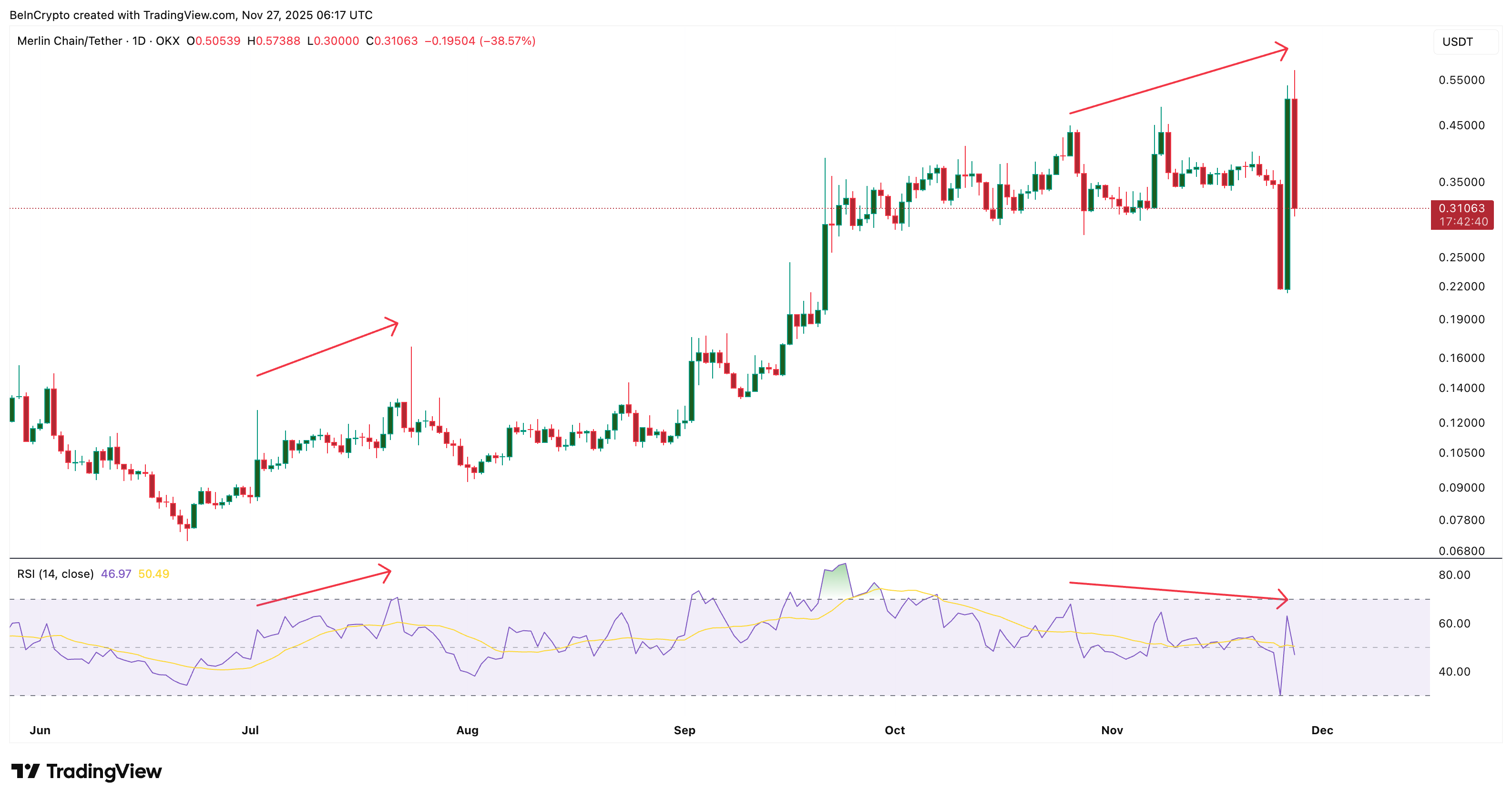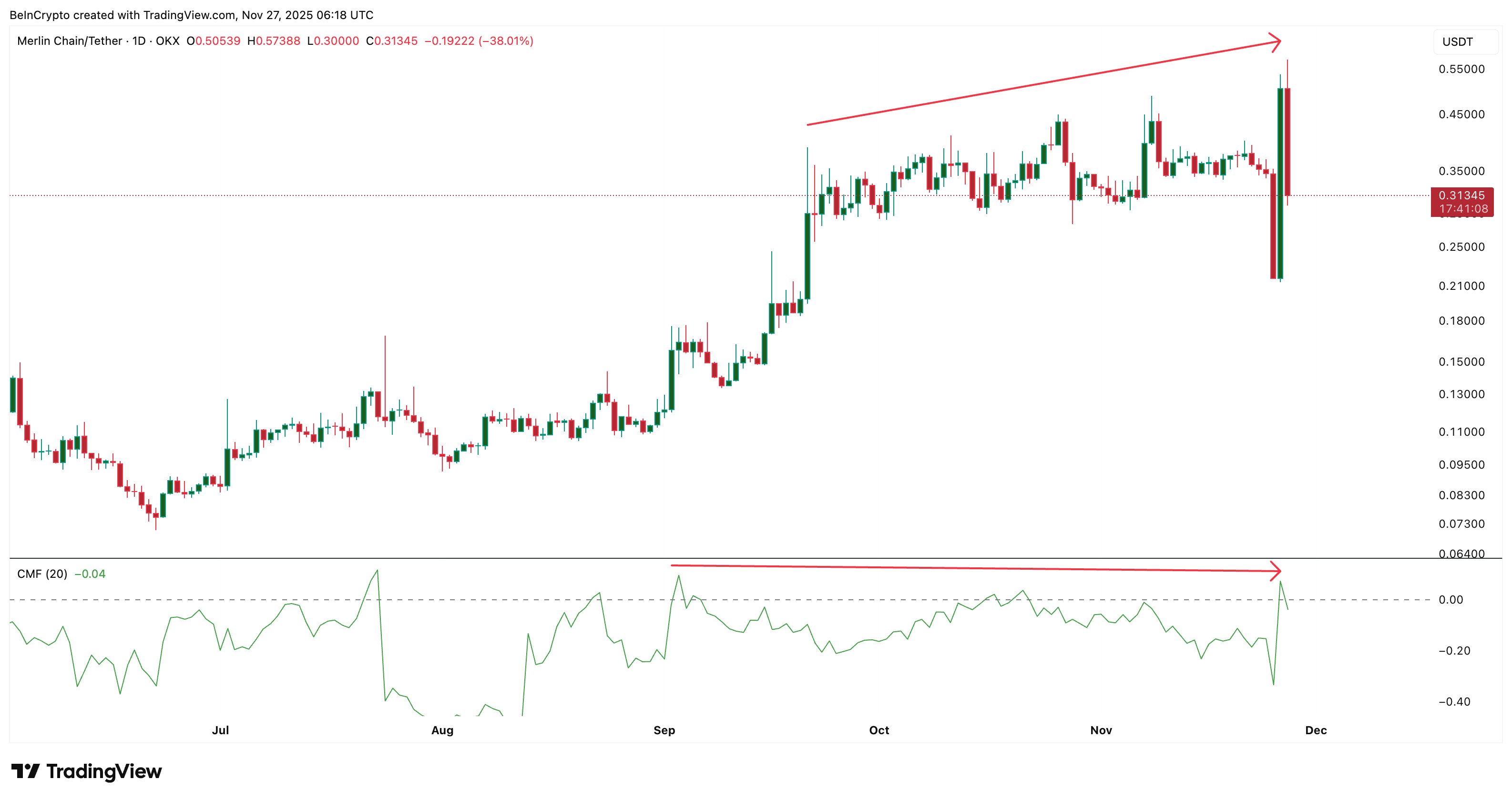Did The 22% Merlin Chain (MERL) Price Rally Just Confirm A Bull Trap?
Merlin Chain (MERL) is a Bitcoin Layer-2 project designed to enable faster, cheaper transactions on the Bitcoin network. The token is up about 22.5% in the past 24 hours and trades near $0.31. Over three months, the Merlin Chain price is still up about 171%. But the past month tells a different story. In that
Merlin Chain (MERL) is a Bitcoin Layer-2 project designed to enable faster, cheaper transactions on the Bitcoin network. The token is up about 22.5% in the past 24 hours and trades near $0.31. Over three months, the Merlin Chain price is still up about 171%. But the past month tells a different story. In that window, MERL is down about 15%, even after the latest spike.
So the question is simple. Did this sharp move up strengthen the trend, or was it more of an outlier? The charts suggest that the 24-hour window rally only strengthened its trend reversal theory. And not in a good way!
Rally Looks Strong, But The Underlying Signals Do Not
Earlier in Merlin Chain’s long uptrend, starting around late June, the price and the Relative Strength Index (RSI) moved together. RSI measures buying and selling strength, and both the price highs and RSI highs kept rising. That is how a healthy rally behaves.
The past month breaks that pattern. Between October 26 and November 26, the Merlin Chain price made a higher high. RSI produced a lower high. That is standard bearish divergence. It often appears near the end of an uptrend, signaling that the next leg may turn down.
 MERL Trend Reversal Coming:
TradingView
MERL Trend Reversal Coming:
TradingView
Want more token insights like this? Sign up for Editor Harsh Notariya’s Daily Crypto Newsletter here.
Chaikin Money Flow (CMF), which tracks whether big buyers are supporting the move, adds more pressure.
From September 21 to November 26, the MERL price made higher highs again. CMF made lower highs and has now fallen under the zero line. A drop under zero, while forming bearish divergence against the price, means large-money inflows have weakened even while the chart pushed to new highs.
 Big Money Slows Down:
TradingView
Big Money Slows Down:
TradingView
The 22% spike did not fix this. In fact, the candle right after the jump turned red, showing that sellers used the strength to exit instead of joining. When both RSI and CMF weaken while price hits new highs, the setup often hints at a bull trap — a fast move up that lures buyers in before the trend reverses.
Key Merlin Chain Price Levels Now Decide If The Uptrend Survives
Now, the existing Merlin Chain price levels decide everything.
The first major resistance sits at $0.38. A clean daily close above $0.38 would weaken the divergence setup and let MERL aim for $0.48 and then $0.57, the near-term peak. That would be the signal that the broader rally from June still holds. However, the move would still need CMF support.
If MERL fails to clear $0.38 and falls under $0.28, the reversal setup grows stronger. The line that confirms the downtrend sits near $0.21. A daily close below $0.21 would complete a clear top and flip the whole three-month structure into a confirmed trend reversal.
 Merlin Chain Price Analysis:
TradingView
Merlin Chain Price Analysis:
TradingView
Right now, the message is straightforward. MERL’s 22% rally saved the short-term chart, but it also revealed that momentum and big-wallet demand are fading. If the key levels fail, this spike will be remembered not as a breakout, but as the move that confirmed the start of the downtrend. And it might even look like a “bull trap” for those who entered at $0.57 or nearby levels.
Read the article at BeInCryptoDisclaimer: The content of this article solely reflects the author's opinion and does not represent the platform in any capacity. This article is not intended to serve as a reference for making investment decisions.
You may also like
Bitcoin News Today: Xapo's Enhanced Bitcoin Fund Signals Growing Institutional Confidence in Digital Assets
- Xapo Bank expanded its Byzantine BTC Credit Fund after $100M in institutional allocations, reflecting growing demand for Bitcoin-backed yield products. - The fund uses Hilbert Group's institutional-grade lending process to generate low-risk returns for Bitcoin holders through collateralized loans. - Xapo's expansion follows 2022 lending sector collapse, leveraging regulatory compliance in Gibraltar/Cayman to rebuild institutional trust in Bitcoin collateral. - The product differentiates from ETFs/stablec

Bitcoin News Update: Movements of Investors' USDT Indicate Bitcoin Highs and Periods of Profit Realization
- Bitcoin's price inversely correlates with USDT outflows, as investors shift liquidity between assets during market cycles. - S&P Global downgraded USDT's stability rating to "weak" due to 5.6% Bitcoin allocation and opaque reserves amid U.S. regulatory reforms. - The GENIUS Act and EU's MiCA framework are reshaping stablecoin markets, forcing Tether and Circle to launch jurisdiction-specific, cash-backed alternatives. - Institutional ETF activity, including Texas's Bitcoin purchases and fragmented inflow

The New Prospects for Economic Growth Infrastructure in Webster, NY
- Webster , NY, leverages $9.8M FAST NY grants and PPPs to transform Xerox campus into a high-tech industrial hub. - Infrastructure upgrades including roads, sewers, and electrical systems aim to attract advanced manufacturing and renewable energy firms. - Governor Hochul's strategy drives $51M in upstate investments, creating 250+ jobs via projects like the $650M fairlife® dairy plant. - Redevelopment boosts industrial land availability and residential property values by 10.1%, with mixed-use zoning enhan

The Impact of Artificial Intelligence on Contemporary Portfolio Management: Potential Benefits and Challenges
- AI redefines portfolio management with real-time analytics and dynamic asset allocation, shifting from static human-driven strategies to data-centric systems. - Generative AI tools like ChatGPT automate financial workflows, enabling hyper-personalized strategies and boosting business outcomes through optimized digital presence. - Risk modeling evolves via AI's pattern detection, but challenges persist in transparency and bias, requiring explainable AI frameworks and human oversight. - Institutions integr

